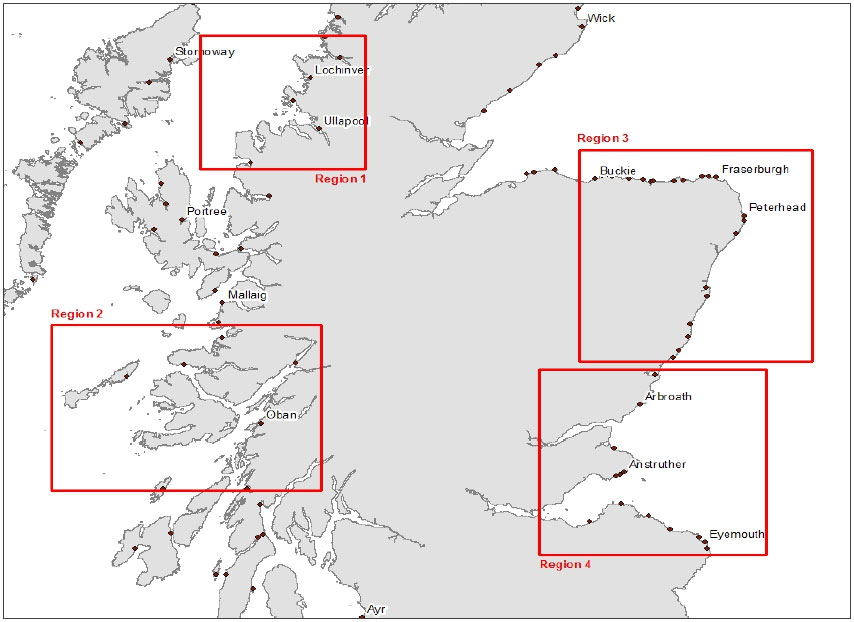Creel fishing: effort study
Report to assess the environmental sustainability of fish stocks and the socioeconomic efficiency of fishing activity.
2. Approach and Survey Sample
Data for this report were obtained from two sources, interviews with static creel fishers and feedback from stakeholder workshops. The interviews with creel fishers were undertaken on the west coast in October to November 2015 and, after requests by industry, extended to the east coast in June to September 2016. The regions surveyed are shown in Figure 1. The regions on the west coast were selected based on the presents of multiple marine users and those on the east coast due to user conflicts within and between fishing sectors.
Lists of all active vessels registered in the four regions were created using the Fisheries Information Network ( FIN), Scotland's central database for fishing activity, and sent to regional fishery offices to review and exclude any vessels not operating at the time of survey. These revised lists became the target list for each regional survey and the aim was to get as close to a census as possible.
Figure 1: Map of survey regions. Region 1 - Achilitibuie to Gairloch (North West); region 2 - Oban to Isle of Mull (South West); region 3 - Buckie to Gourdon (North East); and region 4 - Arbroath to Eyemouth (South East)

Table 1 presents the target population and the achieved survey sample by: number of vessels; landed weight, and; total catch value in 2015. Each interview was undertaken at the quayside with the vessel skipper. The survey collected data on fishing effort, fishing patterns, views on management and lastly each fishing ground and its associated fishing effort were mapped in ArcGIS. Interviews lasted between 30 minutes to 1 hour.
Table 1: Target population and achieved sample by vessel number (#), landed weight (tonnes) and landed value (£) in 2015
| # Vessels | Landed weight (tonnage) | Landed value | |||||||
|---|---|---|---|---|---|---|---|---|---|
| Regions | Target | Surveyed | % | Target | Surveyed | % | Target | Surveyed | % |
| 1. North West | 48 | 31 | 65 | 945 | 450 | 47 | £2,652,534 | £1,354,115 | 51 |
| 2. South West | 74 | 41 | 55 | 659 | 477 | 72 | £2,910,867 | £2,043,498 | 70 |
| 3. North East | 250 | 82 | 33 | 1,715 | 1,315 | 77 | £5,152,380 | £3,963,801 | 77 |
| 4. South East | 164 | 44 | 27 | 1,497 | 750 | 50 | £5,498,483 | £2,892,856 | 53 |
| Species | Target | Surveyed* | % | Target | Surveyed* | % | Target | Surveyed* | % |
| WoS Nephrops | 100 | 55 | 55 | 369 | 283 | 77 | £3,320,293 | £2,626,997 | 79 |
| NS crab/lobster | 314 | 126 | 40 | 1,823 | 1,325 | 73 | £7,111,566 | £4,661,925 | 66 |
| WoS crab/lobster | 85 | 39 | 46 | 1,255 | 390 | 31 | £2,327,578 | £780,308 | 34 |
*These figures total more than the 198 sampled vessels as some vessels took part in more than one fishery. These figures reflect the amount of vessels taken into account in the analysis of each fishery.
The second data set came from two, one-hour stakeholder workshops held at the Scottish Inshore Fisheries Conference in Inverness on the 27-28 th April 2017. Due to available time these workshops focused on future management in the crab and lobster fisheries only on both the west and east coasts. The other key fishery, the west coast Nephrops creel fishery, was not discussed. Stakeholders were asked to pre-register for the workshops and each session had around 30 participants from a range of backgrounds including active fishers, industry associations, fishing representatives, community groups and environmental non-government organisations. At each workshop a 20 minute presentation on the results of the fishing effort survey ( Section 3) was followed by a 20 minute round table discussion on particular topics and then 20 minutes group feedback. The topic discussions focused on four areas: 1) suitable legislation to support crab/lobster fisheries management; 2) implementing appropriate management in the crab and lobster fishery: 3) integrating inshore fishing with wider marine spatial management, and; 4) responding to changing consumer demands and market opportunities.
The findings from the data are summarised in five sections, addressing the questions outlined in the introduction and are as follows:
- Section 3 presents creel effort from the two survey periods from a sample of vessels ( n = 198) and the spatial and seasonal distribution by fishery ( Nephrops and crab/lobster) and coast (East and West Scotland)
- Section 4 presents catch and effort reporting methods and updates to the current system to improve long term data collection
- Section 5 presents fishers' ( n = 198) views on the fisheries and their opinions on management
- Section 6 presents the views from wider stakeholders from the two one-hour workshops on crab and lobster fisheries management
- Section 7 summarises the key findings from all sections
Contact
Email: Estelle Jones, estelle.jones@gov.scot
Phone: 0300 244 4000 – Central Enquiry Unit
The Scottish Government
St Andrew's House
Regent Road
Edinburgh
EH1 3DG
There is a problem
Thanks for your feedback